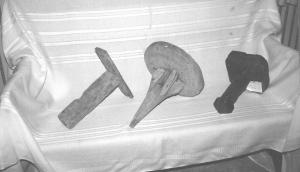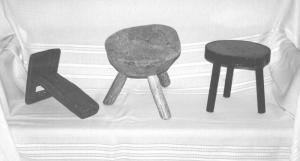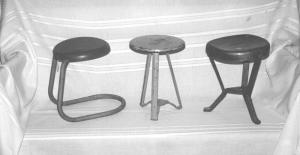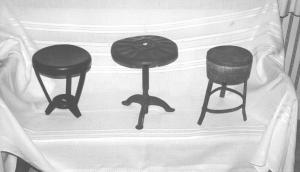Farm Girl Loves Collecting Milk Stools
Jean Hunziker Mehl knows as much about milk stools and their history as anyone around. Jean began collecting stools about 15 years ago. "I bought a stool at an auction with a box of junk. I painted it Ethan Allen blue, and put it in the bathroom."
Since then she has been going great guns. "I now have 192 stools. Each one is different, and they're in different states of repair."
Jean says there are four traditional classifications of milking stools. The first is the pedestal which is a one legged, or tee shaped milking stool. Then there is the four legged milking stool, the bench style and, the rarest of the four, a sanitary milking stool.
Jean explained how the sanitary milking stool worked. "It was designed to keep the milk pail out of the straw and cow manure. There is a long board or platform very similar to a step table with no legs. The flat end of the platform is positioned under the cow with the milk pail setting on it. The dairy person sits on the raised seat."
Jean points out that prohibition resulted in a boom in milk stool production during the 1920's. "Ice cream parlors were very popular during prohibition which caused the government to begin looking at cow barns and classifying grade A milk. If you cleaned up your barns and used metal milking stools, you received a premium on milk."
While many milk stools were factory produced, Jean says many of the most interesting stools are one-of-a-kind, made by farmers from whatever they had on hand. "I have some made with Model T Ford brake drum legs."
When she first started collecting, Jean received many stools from friends and family. One of Jean's most prized stools is the one her husband Harry had in the milking barn where he grew up. "The last milk stool I bought came from Greeley, Colorado. A lady saw a story about one in Country Woman (May/June 1999 issue) and said there was a milk stool at a local antique store that was made in England and ties around your waist so you don't have to pick it up each time you move. I had another one like this from Wisconsin that I bought about five years ago for $20. The new one from Colorado was $85."
Many of Jean's milk stools are stored in the house. "The milk stools are like the children. I keep some in the house and in different places. One stool that is unique was made in Philadelphia and it is unique because the feet were pointed."
When buying stools from antique shops, Jean came up with a way to tell if they are really milking stools. "You can usually see where the farmer grabbed it with his dirty hands. I just dampen the legs a little and see if they smell like manure."
Contact: FARM SHOW Followup, Jean Hunziker Mehl, RR 1, Box 14, Stanford, Ill. 61774 (ph 309 392-2346).

Click here to download page story appeared in.
Click here to read entire issue
Farm Girl Loves Collecting Milk Stools DAIRY EQUIPMENT & IDEAS Dairy Equipment & Ideas 23-6-22 Jean Hunziker Mehl knows as much about milk stools and their history as anyone around. Jean began collecting stools about 15 years ago. "I bought a stool at an auction with a box of junk. I painted it Ethan Allen blue, and put it in the bathroom."
Since then she has been going great guns. "I now have 192 stools. Each one is different, and they're in different states of repair."
Jean says there are four traditional classifications of milking stools. The first is the pedestal which is a one legged, or tee shaped milking stool. Then there is the four legged milking stool, the bench style and, the rarest of the four, a sanitary milking stool.
Jean explained how the sanitary milking stool worked. "It was designed to keep the milk pail out of the straw and cow manure. There is a long board or platform very similar to a step table with no legs. The flat end of the platform is positioned under the cow with the milk pail setting on it. The dairy person sits on the raised seat."
Jean points out that prohibition resulted in a boom in milk stool production during the 1920's. "Ice cream parlors were very popular during prohibition which caused the government to begin looking at cow barns and classifying grade A milk. If you cleaned up your barns and used metal milking stools, you received a premium on milk."
While many milk stools were factory produced, Jean says many of the most interesting stools are one-of-a-kind, made by farmers from whatever they had on hand. "I have some made with Model T Ford brake drum legs."
When she first started collecting, Jean received many stools from friends and family. One of Jean's most prized stools is the one her husband Harry had in the milking barn where he grew up. "The last milk stool I bought came from Greeley, Colorado. A lady saw a story about one in Country Woman (May/June 1999 issue) and said there was a milk stool at a local antique store that was made in England and ties around your waist so you don't have to pick it up each time you move. I had another one like this from Wisconsin that I bought about five years ago for $20. The new one from Colorado was $85."
Many of Jean's milk stools are stored in the house. "The milk stools are like the children. I keep some in the house and in different places. One stool that is unique was made in Philadelphia and it is unique because the feet were pointed."
When buying stools from antique shops, Jean came up with a way to tell if they are really milking stools. "You can usually see where the farmer grabbed it with his dirty hands. I just dampen the legs a little and see if they smell like manure."
Contact: FARM SHOW Followup, Jean Hunziker Mehl, RR 1, Box 14, Stanford, Ill. 61774 (ph 309 392-2346).
To read the rest of this story, download this issue below or click
here to register with your account number.










